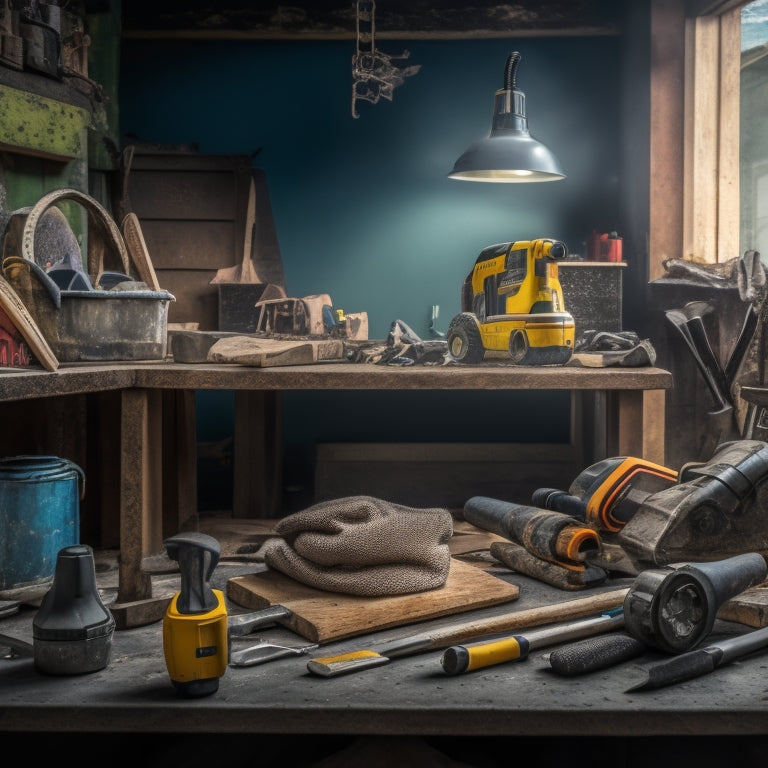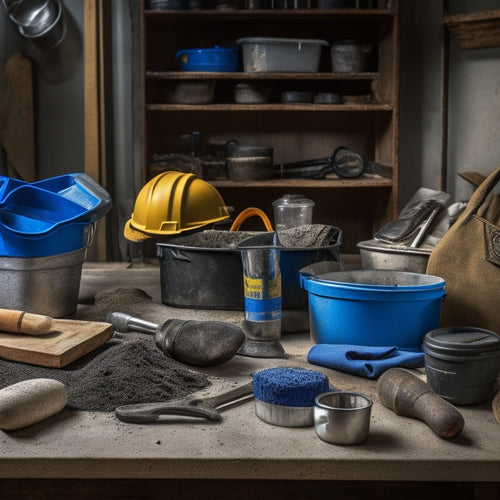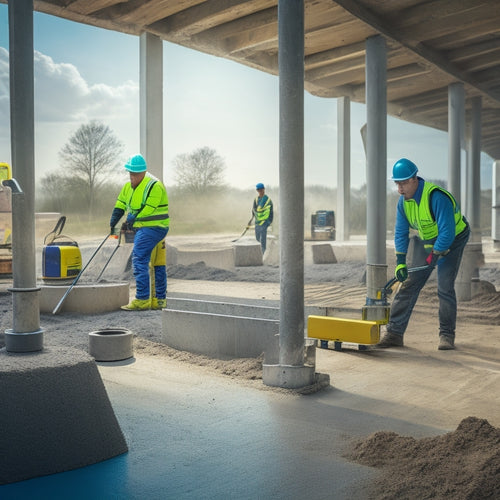
What Tools Do You Need to Split Concrete Blocks
Share
When splitting concrete blocks, you'll need a range of tools to get the job done efficiently and safely. Start with essential safety gear like gloves, safety glasses, and a dust mask. Next, grab measuring and marking tools such as a tape measure, level, and reliable marker. Handheld splitting tools like wedges, shims, and tamping bars will help you apply targeted force. For more power, consider electric or pneumatic options, or invest in a hydraulic splitter or specialized machine. With the right tools in hand, you'll be ready to tackle your concrete block splitting project - and with the right techniques, you'll be able to achieve professional-level results.
Key Takeaways
• Essential safety gear, including safety glasses, gloves, and ear protection, is necessary for operators to prevent injuries during concrete block splitting.
• Measuring and marking tools like tape measures, levels, and markers are required to accurately mark and split concrete blocks.
• Handheld splitting tools, such as wedges, shims, and tamping bars, are used to apply pressure and break apart concrete blocks.
• Power tools, including electric and pneumatic splitters, rotary hammers, and diamond blades, are needed for efficient and precise block splitting.
• Specialized block splitting machines, like hydraulic and pneumatic machines, can be used for large-scale projects, requiring regular maintenance for optimal performance.
Essential Safety Gear for Operators
You'll need to wear essential safety gear to protect yourself from the hazards associated with splitting concrete blocks, including flying debris, heavy equipment, and respiratory risks.
Don't think you can wing it – safety training is vital to avoid accidents. Your personal protective equipment (PPE) should include safety glasses, gloves, and a dust mask to prevent injuries from flying particles and airborne contaminants.
A hard hat and steel-toed boots will protect you from falling objects and heavy machinery. Don't forget earplugs to safeguard your hearing from the loud machinery.
It's also important to wear long-sleeved shirts, long pants, and closed-toe shoes to prevent skin exposure. Remember, safety gear isn't a fashion statement, but a necessity.
Take it seriously, and you'll be splitting concrete blocks like a pro in no time. So, gear up and get ready to tackle the task at hand – safely!
Measuring and Marking Tools Needed
Accurate measurements and markings are crucial to splitting concrete blocks efficiently, and a set of reliable measuring and marking tools is fundamental to get the job done right. You don't want to be stuck with a bunch of miscalculated blocks; trust us, it's a real concrete nightmare! To avoid that, you'll need a few trusty tools in your arsenal.
First, grab a high-quality tape measure to guarantee accurate length and width measurements. You'll also need a level to ensure your blocks are perfectly aligned. Don't forget a sturdy straightedge or combination square to guide your marking tools.
Speaking of which, a reliable marker or chalk line will help you create clear, precise markings on the concrete surface.
When it comes to measuring techniques, consider using a laser level for added precision. For marking methods, try using a marker with a fine tip for detailed work or a thicker marker for more visible lines.
With these tools and techniques, you'll be splitting concrete blocks like a pro in no time!
Handheld Splitting Tools Overview
As you prepare to split concrete blocks, you'll need to choose the right handheld tool for the job.
You'll have to take into account the type of tool, its splitting force, and how it'll impact your control over the splitting process.
Types of Handheld Tools
When tackling concrete block splitting projects, handheld tools prove invaluable for their ease of use, portability, and precision. You'll find that these tools are perfect for smaller projects or when you need to make precise cuts. There are various types of handheld tools to choose from, each with its unique characteristics.
For instance, you can opt for hand tools made from high-carbon steel, which offer exceptional durability and resistance to corrosion. Alternatively, you might prefer tools with ergonomic handles, designed to reduce fatigue and provide a comfortable grip.
Regardless of your choice, it's crucial to prioritize tool maintenance. Regularly clean and lubricate your tools to prevent rust and guarantee they remain in top condition.
When selecting handheld tools, consider the type of concrete block you're working with. Are you dealing with dense, heavy blocks or lighter, more porous ones? Different tools are better suited for specific block types.
Splitting Force and Control
You need to balance splitting force and control to effectively split concrete blocks, and handheld splitting tools are designed to provide this delicate balance. When you're working with concrete, you don't want to apply too much force and end up shattering the block, nor do you want to apply too little and struggle to make progress.
Handheld splitting tools, like breakers and splitters, are engineered to distribute force efficiently, allowing you to target the exact spot where you want the block to split.
Mastering the art of force distribution is key to successful block splitting. By using the right control techniques, you can direct the force exactly where you need it, ensuring a clean split every time.
For instance, some handheld tools feature adjustable handles that let you tailor the force to the specific block you're working with. Others have specialized tips that help you precision-target the splitting point.
Operator Safety Considerations
Mastering force distribution and control techniques is only half the battle; using handheld splitting tools also requires prioritizing operator safety to prevent injuries and maintain a productive work environment.
You don't want to be that person who gets caught up in the excitement of splitting concrete blocks and forgets to wear safety goggles – only to end up with a face full of debris.
To avoid such mishaps, it's crucial to undergo operator training that covers safety protocols and best practices. This training should emphasize the importance of wearing personal protective equipment (PPE) like gloves, safety glasses, and ear protection.
You should also learn how to properly handle and maintain your tools, as well as how to respond in case of an emergency.
Electric and Pneumatic Options
Electric and pneumatic tools, such as demolition saws and rotary hammers, offer high-powered splitting capabilities for concrete blocks. When you need to split concrete blocks efficiently, these tools are the way to go. You'll find that electric block splitters are ideal for smaller, more precise jobs, while pneumatic splitters are better suited for larger, more demanding projects.
Here's a quick comparison of electric and pneumatic options:
| Tool Type | Advantages |
|---|---|
| Electric Block Splitter | Lightweight, portable, and easy to use; ideal for small to medium-sized blocks |
| Pneumatic Splitter | High-powered, fast, and efficient; suitable for large, heavy blocks |
| Rotary Hammer | Versatile, powerful, and great for demolition work; can be used for splitting and drilling |
When choosing between electric and pneumatic tools, consider the size and type of concrete blocks you need to split, as well as your personal comfort level with the tool's power and weight. Remember, the right tool for the job will make all the difference in your productivity and results.
Hydraulic Splitter Requirements
Operating a hydraulic splitter requires careful planning and attention to specific safety protocols and equipment requirements to guarantee efficient and safe concrete block splitting.
You'll need to choose the right hydraulic splitter type for your project, considering factors like the size and weight of the blocks, as well as the required hydraulic pressure.
Here are some essential requirements to keep in mind:
-
Hydraulic pressure requirements: Confirm your splitter can generate the necessary pressure (typically between 10,000 to 20,000 PSI) to split the blocks efficiently.
-
Hydraulic fluid type and capacity: Use the recommended hydraulic fluid type and maintain the required fluid level to prevent overheating and damage.
-
Hose and fitting durability: Inspect hoses and fittings regularly to prevent damage and confirm secure connections.
-
Operator training: Familiarize yourself with the splitter's operation, safety features, and emergency procedures.
-
Maintenance schedule: Regularly inspect and maintain the splitter to prevent mechanical failures and ensure peak performance.
Wedge and Shims for Splitting
You'll need to pair your hydraulic splitter with the right wedge and shims, as these tools work in tandem to facilitate controlled, precise splitting of concrete blocks.
The wedge is the star of the show, applying pressure to the block's weakest point to initiate the split. There are various wedge types to choose from, including flat, curved, and notched, each suited for specific block sizes and shapes. When selecting a wedge, consider the block's dimensions, its intended use, and the type of split you want to achieve.
Shims, on the other hand, provide additional support and guidance for the wedge, ensuring a clean, straight split. Shim materials range from steel and aluminum to wood and plastic, each offering unique benefits and drawbacks. Steel shims, for instance, are durable and long-lasting, while wooden shims are more affordable and environmentally friendly.
Tamping and Chiseling Tools
When you're working with concrete blocks, you'll need to use tamping bars to compact and settle the material.
You'll also rely on hand chisel methods to carefully break away excess concrete and refine the split.
Tamping Bars Used
Tamping bars, essential tools in the concrete block splitting process, deliver precise blows to dislodge and break apart stubborn blocks. You'll rely on these bars to apply controlled force, helping you to avoid damaging surrounding surfaces or the blocks themselves. When selecting a tamping bar, consider the material it's made of - you'll want something durable that can withstand the rigors of repeated use.
Some key factors to keep in mind when using tamping bars include:
-
Tamping techniques: experiment with different angles and striking patterns to find what works best for you.
-
Tamping materials: choose bars made from high-carbon steel or fiberglass for maximum strength and durability.
-
Handle length and grip: look for a comfortable, secure grip that helps you maintain control.
-
Weight and balance: a well-balanced bar makes it easier to generate force without straining your back or arms.
-
Tip shape and size: a flat, broad tip is often more effective at dislodging blocks than a pointed one.
Hand Chisel Methods
Hand chisels, versatile tools that combine tamping and chiseling functions, enable you to target specific areas of the concrete block with precision, making them an important component of your splitting arsenal. These tools allow for a more controlled and deliberate approach, especially when you need to split blocks with intricate cuts or patterns.
To get the most out of your hand chisel, it's vital to master various chisel techniques. For instance, you'll want to use a gentle tapping motion to create a series of small cracks, gradually increasing the force as needed. Additionally, pay close attention to block alignment, ensuring the chisel is perpendicular to the block's surface to maximize the splitting effect. By doing so, you'll be able to efficiently split concrete blocks with ease.
Power Tool Accessories Required
You'll need to equip your power tool with the right accessories to efficiently split concrete blocks, including a diamond blade or a concrete cutting wheel. Don't even think about attempting to split concrete without these essential add-ons – you'll end up with a mangled mess and a power tool that's begging for mercy.
Here are the must-have accessories to get the job done:
-
Diamond blade: A high-quality diamond blade is designed specifically for cutting through concrete and will make the job a whole lot easier.
-
Concrete cutting wheel: This wheel is designed for heavy-duty cutting and is perfect for larger concrete blocks.
-
Dust mask: You don't want to breathe in all that concrete dust, trust us.
-
Safety glasses: Protect those peepers from flying debris!
-
Power tool maintenance kit: Keep your power tool in top condition with regular maintenance to avoid breakdowns and prolong its lifespan.
Specialized Block Splitting Machines
When power tools aren't enough, specialized block splitting machines take over, providing a more efficient and accurate way to split concrete blocks, especially for larger-scale projects or heavy-duty applications.
These machines are designed to handle the tough stuff, and you'll be glad you invested in one when you're dealing with hundreds of blocks.
There are various block splitter types, including hydraulic, pneumatic, and manual machines, each with its own strengths and weaknesses.
Hydraulic machines are the most powerful, but also the most expensive.
Pneumatic machines are a good middle ground, offering a balance of power and affordability.
Manual machines are the most budget-friendly, but require more elbow grease.
Regardless of which type you choose, regular machine maintenance is essential to guarantee peak performance and extend the machine's lifespan.
Make sure to follow the manufacturer's instructions for maintenance, and don't be afraid to get your hands dirty.
With the right machine and proper maintenance, you'll be splitting blocks like a pro in no time!
Frequently Asked Questions
Can I Use a Regular Hammer to Split Concrete Blocks?
Don't even think about using a regular hammer to split concrete blocks!
You'll just end up with a bent hammer and a block that's still intact.
You need a heavy-duty hammer, like a sledgehammer or a demolition hammer, to crack that block.
The type of hammer you choose depends on the block's durability - thicker blocks require more force.
How Do I Prevent Block Splitting From Damaging Surrounding Structures?
Remember that time a demolition crew split a concrete block, only to have the adjacent wall come crashing down?
You don't want that to happen on your watch! When splitting concrete blocks, you'll need to prioritize surrounding structure protection.
Implement block reinforcement techniques, like installing steel rebar or fiber mesh, to contain the force.
Cover adjacent surfaces with protective barriers, and consider temporarily supporting nearby structures.
You got this!
What Safety Precautions Should I Take When Working With Hydraulic Splitters?
When operating hydraulic splitters, you'll want to prioritize hydraulic safety to avoid getting crushed - literally!
First, don your personal protective gear: safety glasses, gloves, and a hard hat.
Make certain the splitter is on a level surface, away from obstructions.
Keep bystanders at a safe distance, and never place your hands or feet under the splitter's pressure zone.
Stay alert and focused, and you'll be splitting concrete like a pro - without splitting your skull!
Can I Split Concrete Blocks Underwater or in Wet Conditions?
Oh, you want to split concrete blocks underwater? Because, why not, right? It's not like you'll be dealing with water pressure, visibility issues, or rusting equipment.
But seriously, underwater techniques are a thing, and you can use specialized tools for it. However, wet conditions challenges are no joke.
Water weakens concrete, making it more prone to crumbling, and your splitter will need to be designed for underwater use.
Do I Need to Cure the Blocks Before Splitting Them?
Before you start splitting, you're wise to wonder if curing those blocks is necessary. The answer is yes, you should!
Skipping the curing process can compromise block strength, making them more prone to cracking or shattering. Think of it like baking a cake - you need to let it set before slicing.
Give those blocks the time they need to fully harden, and you'll get a cleaner split. Trust us, your demolition skills (and the blocks) will thank you.
Conclusion
As you stand amidst the rubble of freshly split concrete blocks, the fruits of your labor scattered around you, remember that the right tools made all the difference.
Like a master sculptor, you've coaxed these blocks into submission, revealing the hidden beauty within.
But without the essential safety gear, measuring tools, and splitting devices, your masterpiece would remain trapped, forever bound by unyielding concrete.
Related Posts
-

5 Tools Needed for Quick Fix Concrete Mixing
You'll need five essential tools to tackle a quick fix concrete mixing project efficiently. First, you'll require a s...
-

Essential Power Tools for DIY Concrete Sculpting
As you begin DIY concrete sculpting, you'll need a strategic selection of power tools to achieve professional-grade r...
-

What Tools Ensure Precise Concrete Leveling Results
You need a range of specialized tools to achieve precise concrete leveling results. Laser leveling instruments provid...


